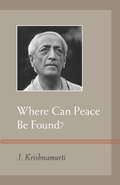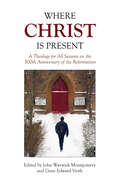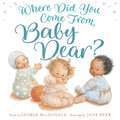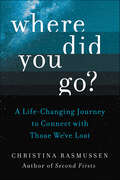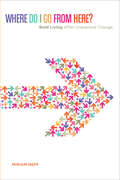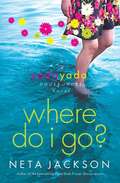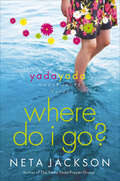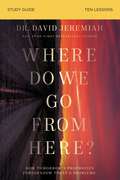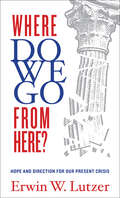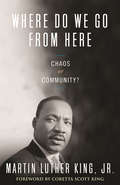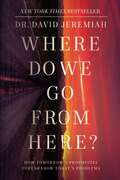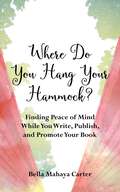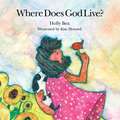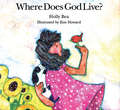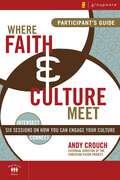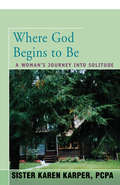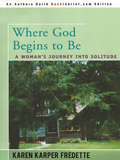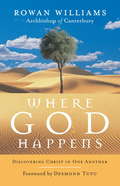- Table View
- List View
Where Can Peace Be Found?
by J. KrishnamurtiWidely recognized as one of the most influential spiritual teachers of the twentieth century, Jiddu Krishnamurti taught that in order for there to be peace in the world, we must each first make peace with ourselves. No spiritual path, leader, or personal or political philosophy will guide us in this endeavor, he said; this transformation of the human psyche is a truth that each of us must discover within. Here, Krishnamurti teaches that the war and destruction human beings wreak on each other and the environment are caused by our misplaced attachment to a sense of self and individuality that leads to aggression, competition, greed, and conflict. When we recognize that our consciousness is not individual but common to all humans, we can work together in a spirit of cooperation and compassion. Krishnamurti shows that taking personal responsibility for our actions and reactions—in our relationships and in our lives—is the necessary first step toward a global view
Where Christ Is Present: A Theology for All Seasons on the 500th Anniversary of the Reformation
by Gene Edward Veith John Warwick MontgomeryFive hundred years ago, the church of Jesus Christ underwent a Reformation. A lot happened after Martin Luther posted his 95 theses on the castle church door in Wittenberg. But the fallout was not simply the start of Protestantism. The Roman Catholic Church also recast itself in response to Luther's call for reforms. And contrary to common belief, Martin Luther did not set out to start a new church. Rather, he was trying to reform the church that already existed by reemphasizing its essence-namely, the "good news" (the gospel) that Jesus forgives and saves sinners. The unity of the church was broken when the pope rejected this call for reform and excommunicated Luther, starting a chain of events that did lead to the institutional fracturing of Christendom and to a plethora of alternative Christian theologies. But, as many - including conservative Catholics - now admit, the church did in fact need reforming. Today, the church - including its Protestant branches - also needs reforming. Some of the issues in contemporary Christianity are very similar to those in the late Middle Ages, though others are new. But if Luther's theology can be blamed - however unfairly - for fragmenting Christianity, perhaps today it can help us recover the wholeness of Christianity. The religious climate in the early 21st-century is simultaneously highly religious and highly secularized. It is a time of extraordinary spiritual and theological diversity. In the spirit of the anniversary we are observing, this book will propose the kind of Christianity that is best suited for our day. The remedies offered here are available by way of the same theology that was the catalyst for reforming the church five hundred years ago.
Where Courage Calls (Return to the Canadian West #1)
by Janette Oke Laurel Oke LoganIn the early 20th century, new schoolteacher Beth Thatcher is assigned a post in a remote mining community in Western Canada. There her courage and her heart will be tested in unexpected ways. This is the first entry in the Return to the Canadian West series which continues from the author's Canadian West / When Calls the Heart series which began in the 1980s.
Where Did You Come from, Baby Dear?
by George MacDonaldA perfect baby shower gift from a bestselling and beloved artist known for capturing the special moments of family life.Where did you get those eyes so blue? What makes the light in them sparkle and spin? What makes your forehead so smooth and high?The questions new parents ask as they look in amazement on their just-born child are celebrated and fancifully answered in this inspirational poem, brought for the first time to picture-book life. George MacDonald's lovely ode to newborn babies is beautifully animated in soft colored pencil by a treasure of the children's book world, Jane Dyer. Feauturing a diverse cast of newborns, this classic, moving, and lightly spiritual poem marvels at the miracle of new life.
Where Did You Go?: A Life-Changing Journey to Connect with Those We've Lost
by Christina Rasmussen“Where Did You Go? offers deep comfort to anyone who has lost a loved one and hopes to explore what frontier science is now demonstrating: while a heart may stop beating, consciousness never dies.”—Lynne McTaggart, bestselling author of The FieldFrom Christina Rasmussen, the much beloved and acclaimed author of Second Firsts, comes a groundbreaking exploration of the afterlife that combines spirituality with cutting edge science—and reveals we all have the power to connect with our loved ones on the other side. “Where did you go?” This was the first question Christina Rasmussen asked after the death of her husband. A young widow with two daughters, Rasmussen would go on to become an esteemed grief educator who helped countless others rebuild their lives after loss. Yet, even as she learned to thrive again, that first heartbreaking question persisted. Even as she and her clients forged new paths and discovered new joy, the same questions remained: Are we capable of connecting to those who have passed on? What really happens after we die?As a professional grounded in science, Christina was a skeptic who shied away from the conventional mystical, supernatural, and religious descriptions of the afterlife—so she turned to what seemed “provable” to unravel the mystery of life beyond life: physics. What she found was beyond anything she could have expected: not only is there life after death, but we all have the ability to connect with loved ones who have passed on.Sharing an inspiring message of hope, optimism, and love, Where Did You Go? is a transporting step-by-step guide to journeying to the other side, from one of our most trusted voices on life after loss. Bridging the gap between the metaphysical and the measurable, it will change the way we grieve, the way we live and how we define our potential—in this life and the hereafter.
Where Do Diggers Celebrate Hanukkah? (Where Do...Series)
by Brianna Caplan SayresCelebrate Hanukkah with your favorite Diggers! For fans of the bestselling Where Do Diggers Sleep at Night? and its companion holiday vehicle books.It's Hanukkah! How do you celebrate? Do you light the menorah? Play dreidel with your friends? How about eating latkes and sufganiyot? Read all about diggers, cranes, cement mixers—and more—enjoying fun and festive Hanukkah nights after the sun sets!Children who can't get enough of trucks will love all the books in the bestselling Where Do... series.Where Do Diggers Sleep at Night?Where Do Diggers Celebrate Christmas?Where Do Diggers Trick or Treat?Where Do Diggers Take Vacation?Where Do Diggers Say I Love You?Where Do Steam Trains Sleep at Night?Where Do Jet Planes Sleep at Night?Where Do Speedboats Sleep at Night?
Where Do Diggers Hunt for Easter Eggs? (Where Do...Series)
by Brianna Caplan SayresCelebrate Easter with your favorite Diggers! For fans of the bestselling Where Do Diggers Sleep at Night? and its companion truck books.How do you celebrate Easter? Do you dress up in your Easter best? Dye eggs bold and bright? How about going to a parade? For sure! Follow diggers, cranes, cement mixers—and more—for a fun and festive day full of surprises! Children who can't get enough of trucks will love all the books in the bestselling Where Do... series.Where Do Diggers Sleep at Night?Where Do Diggers Celebrate Christmas?Where Do Diggers Trick or Treat?Where Do Diggers Take Vacation?Where Do Diggers Say I Love You?Where Do Steam Trains Sleep at Night?Where Do Jet Planes Sleep at Night?Where Do Speedboats Sleep at Night?
Where Do I Go From Here?
by Nicholas ComninellisStories of young adults who made decisions - and the dramatic outcomes. Excellent guide for those who are facing big choices Explains how to focus on the right motives behind life decisions Teaches how to make wise decisions Advice is biblically founded Perfect gift for graduates Life is full of decisions - both major and minor. Should I take this job? Should I go to college? What if he asks me to marry him? This book is especially aimed at young people and the decision-making processes of their lives. Its goal is to help young people become more effective by focusing on the right motives, looking ahead to potential outcomes, and ultimately turning to Jesus Christ for guidance. A beautiful gift book full of vignettes of young people faced with decisions, and how they tackled each one.
Where Do I Go From Here?: Bold Living After Unwanted Change
by Miriam NeffLife has a way of tilting. Jobs are lost. Children leave. Homes foreclose. Spouses die. Everyone experiences the loss of something or someone precious at some point. And more often than not a loss is unexpected, certainly unwanted, and can be our undoing.Miriam Neff, M.A. in counseling, has experienced loss in many manifestations from her beloved soul mate Bob going home to the Lord to a close family member&’s incarceration. Yet, she has learned &“that good things are still possible.&” &“Life is like a kaleidoscope. We point our sphere toward the light, peer in, and see a beautiful array of glass and stones reflecting beauty, diversity, and contrast. We adjust the lens, and another beautiful, yet different combination of color evolves. Then suddenly the kaleidoscope is thrust to face a black hole. No light means no beautiful display. When you timidly, maybe fearfully, tilt your kaleidoscope back toward the light, you&’ll see a new combination you&’ve never seen before, colors you didn&’t know existed. Location and contrast create new and unexpected beauty. &“ More than a &“survival&” book, Where Do I go From Here raises the bar in life after loss to include love, laughter, and adventure. This is a book about facing forward, not backwards. It is about purposely moving into a bolder and broader future.Includes practical help and chapter discussion questions for individual or group study.
Where Do I Go From Here?: Bold Living After Unwanted Change
by Miriam NeffLife has a way of tilting. Jobs are lost. Children leave. Homes foreclose. Spouses die. Everyone experiences the loss of something or someone precious at some point. And more often than not a loss is unexpected, certainly unwanted, and can be our undoing.Miriam Neff, M.A. in counseling, has experienced loss in many manifestations from her beloved soul mate Bob going home to the Lord to a close family member&’s incarceration. Yet, she has learned &“that good things are still possible.&” &“Life is like a kaleidoscope. We point our sphere toward the light, peer in, and see a beautiful array of glass and stones reflecting beauty, diversity, and contrast. We adjust the lens, and another beautiful, yet different combination of color evolves. Then suddenly the kaleidoscope is thrust to face a black hole. No light means no beautiful display. When you timidly, maybe fearfully, tilt your kaleidoscope back toward the light, you&’ll see a new combination you&’ve never seen before, colors you didn&’t know existed. Location and contrast create new and unexpected beauty. &“ More than a &“survival&” book, Where Do I go From Here raises the bar in life after loss to include love, laughter, and adventure. This is a book about facing forward, not backwards. It is about purposely moving into a bolder and broader future.Includes practical help and chapter discussion questions for individual or group study.
Where Do I Go? (Yada Yada House of Hope, Book #1)
by Neta JacksonSometimes you find hope in the last place you look. Gabrielle Fairbanks has nearly lost touch with the carefree, spirited young woman she was when she married her husband sixteen years ago. But when the couple moves to Chicago to accommodate Philip's ambition, Gabby longs for the chance to find real purpose in her own life. A chance encounter with a homeless woman suddenly opens a door she never expected. The women of Manna House Women's Shelter need a Program Director--and she has the right credentials. Gabby's in her element, feeling God's call on her life at last, even though Philip doesn't like the changes he sees in her. But she never anticipated his ultimatum: quit your job at the shelter or risk divorce and losing custody of our sons. In this moment, Gabby's entire foundation shifts. She must find refuge, as in the song they sing at Sunday worship: "Where do I go when there's no one else to turn to . . . I go to the Rock I know that's able, I go to the Rock." For everyone who loves the best-selling Yada Yada Prayer Group novels comes a brand new series sprinkled with familiar faces and places from the Yada Yada world. It's the perfect novel to start with -- or to meet friends from past Yada stories.
Where Do I Go?: A Yada Yada House of Hope Novel (The Yada Yada House of Hope Novels #1)
by Neta JacksonSometimes you find hope in the last place you look.Gabrielle Fairbanks has nearly lost touch with the carefree, spirited young woman she was shen she married her husband sixteen years ago. But when the couple moves to Chicago to accommodate Philip's ambition, Gabby longs for the chance to find real purpose in her own life.A chance encounter with a homeless woman suddenly opens a dooor she never expected. The women of Manna House Women's Shelter need a Program Director--and she has the right credentials. Gabby's in her element, feeling God's call on her life at last, even though Philip doesn't like the changes he sees in her. But she never anticipated his ultimatum: quit your job at the shelter or risk divorce and losing custody of our sons.In this moment, Gabby's entire foundation shifts. She must find refuge, as in the song they sing at Sunday worship: "Where do I go when there's no one else to turn to . . . I go to the Rock I know that's able, I go to the Rock."For everyone who loves the best-selling Yada Yada Prayer Group novels comes a brand new series sprinkled with familiar faces and places from the Yada Yada world. It's the perfect novel to start with--or to meet friends from past Yada stories.
Where Do My Pets Go When They Die?
by John MarkMost of us have lost a beloved pet, and been left to ponder, What's next? In Where do my Pets Go When They Die? author John Mark explores a very sensitive, albeit controversial topic. The loss of a cherished family friend challenges us to dig more deeply into the Scriptures for comfort, but also in order to answer this extremely important question. Although, it is not undertaken often, this subject is an area of focus and deep concern for many pet lovers of any age, anywhere in the world, at any moment in time. In tackling this question, the author's ultimate hope is to inspire readers to look for peace as well as answers in the Word of God.
Where Do We Go From Here? Bible Study Guide: How Tomorrow’s Prophecies Foreshadow Today’s Problems
by Dr. David JeremiahJesus Will Show You the Way ForwardToday&’s headlines shout of modern plagues, social tensions, economic crises, and rampant depression. Many are asking, &“What day is it on God&’s prophetic calendar?&” Trusted Bible teacher and pastor Dr. David Jeremiah answers this question by opening up the Word of God to reveal what it has to say about the days in which we are living and offer hope to believers.In this ten-lesson accompanying study guide, Dr. Jeremiah deals with ten prophetic issues as current as the morning news. You will thread your way through problems that Jesus predicted—precursors of the Tribulation—and learn what steps you should take to navigate them. Even as the world collapses, you can be sure that the Lord is building His Church! You can say something, do something, pray something, preach something, and live by the convictions of Christ.Each lesson includes:An outline of the main subjects and Scriptures covered during the lesson.An overview of Dr. Jeremiah&’s teaching on the topic being studied.Application questions to help both individuals and small groups delve into the content and the Bible.A Did You Know? Section that adds a point of interest to the lesson.This is no time to be discouraged. Your risen and exalted Lord Jesus Christ—your enthroned Savior—knows the way forward. He will show you where to go from here.
Where Do We Go From Here?: Hope and Direction in our Present Crisis
by Erwin W. LutzerThe America you thought you knew is gone. No longer is this a nation based on godly principles and morality. America is following its leaders willingly into economic, moral, and political decline. What are Christians to do? Erwin Lutzer offers hope and a challenge to Christians. It is not time to despair even as we face these difficult realities. Two thousand years of church history are behind us to show that the church does not need freedom or ease in order to be faithful. God&’s calling on His people can be fulfilled no matter what. Dr. Lutzer calls Christians to be agents of change in these increasingly secular times, and he offers hope and direction. As the nation morphs, Christians are called to adjust, to be faithful ambassadors for Christ in a country where many are turning away from Him.
Where Do We Go From Here?: Hope and Direction in our Present Crisis
by Erwin W. LutzerThe America you thought you knew is gone. No longer is this a nation based on godly principles and morality. America is following its leaders willingly into economic, moral, and political decline. What are Christians to do? Erwin Lutzer offers hope and a challenge to Christians. It is not time to despair even as we face these difficult realities. Two thousand years of church history are behind us to show that the church does not need freedom or ease in order to be faithful. God&’s calling on His people can be fulfilled no matter what. Dr. Lutzer calls Christians to be agents of change in these increasingly secular times, and he offers hope and direction. As the nation morphs, Christians are called to adjust, to be faithful ambassadors for Christ in a country where many are turning away from Him.
Where Do We Go from Here: Chaos or Community? (King Legacy #2)
by Martin Luther King Jr. Coretta Scott King Vincent HardingIn 1967, Dr. Martin Luther King, Jr., isolated himself from the demands of the civil rights movement, rented a house in Jamaica with no telephone, and labored over his final manuscript. In this prophetic work, which has been unavailable for more than ten years, he lays out his thoughts, plans, and dreams for America's future, including the need for better jobs, higher wages, decent housing, and quality education. With a universal message of hope that continues to resonate, King demanded an end to global suffering, asserting that humankind-for the first time-has the resources and technology to eradicate poverty.
Where Do We Go from Here?: How Tomorrow’s Prophecies Foreshadow Today’s Problems
by Dr. David JeremiahToday&’s headlines shout of modern plagues, social tensions, economic crises, and rampant depression. Many are asking, what day is it on God&’s prophetic calendar? Trusted Bible teacher and Pastor, Dr. David Jeremiah opens up the Word of God to reveal what it has to say about the days we are living in.Sharing how prophecies and wisdom from centuries ago still speak the truth today and point the way forward for tomorrow. Whether one is new to biblical prophecy or a longtime student of the Bible, this timely message will encourage and recalibrate us to the mission of God in our daily lives. Journey with Dr. Jeremiah back to the Bible to find out, Where Do We Go from Here?
Where Do You Hang Your Hammock?: Finding Peace of Mind While You Write, Publish, and Promote Your Book
by Bella Mahaya CarterIn Where Do You Hang Your Hammock? seasoned coach and author Bella Mahaya Carter shows writers how to use their present circumstances as stepping-stones to a successful and meaningful writing life, navigated from the inside out. It encourages writers and authors to rethink their ambitions (which may be fueled by the tyrannical demands of the ego) and trust in their heartfelt purpose and values in the journey to becoming, or continuing on, as authors.Many writers believe their self-sabotaging thoughts are trustworthy and true. They take rejection personally. They surmise that if they don&’t achieve their goals they have failed, and lose sight of who they are and what matters most.This book is for writers looking for inspiration and for authors daunted by the publishing process, who might lack the requisite author platform to get published the way they dreamed, or whose careers may not be unfolding as expected. It aims to be the friend and trusted expert writers turn to when hijacked by their own thinking. Ultimately, it reminds authors that they are infinite creators.
Where Does God Live?
by Kim Howard Holly BeaA lively and inquisitive young girl named Hope asks a really big question: Where does God live? Her grandmother provides Hope with an answer that she and all readers can take to heart. Picture descriptions added.
Where Does God Live?
by Kim Howard Holly Bea"Where does the sun go? Why does it rain? Why don't snowflakes all look the same?" These are some of the questions that a lively and inquisitive young girl named Hope dreams up. Her favorite pastime is asking questions -- and she's good at it! She asks everyone she knows just about anything. One day her musings lead her to a really big question: Where does God live? She talks to her mom. She questions her animal friends. Finally, it is her wise and gentle grandmother whose lifetime of faith offers Hope, the answer that she and all of us can take into our hearts. It is an answer whose simplicity does honor to the Creator.
Where Faith and Culture Meet Participant's Guide (Intersect / Culture)
by Andy CrouchTake Your Group to a Place …Where they can see people’s needs in a new wayWhere they can understand their callingWhere they will learn how their faith can shape cultureThis six-session DVD and corresponding curriculum helps your group experience and envision how followers of Christ can be a counterculture for the common good. Together you’ll experience stories of other believers who changed the culture around them, including Andy Crouch, Mako Fujimara, Rudy Carrasco, Mark Buchanan, Tal James, Frederica Mathewes-Green, and others. You’ll watch how their journeys unfolded, their challenges, and their breakthroughs. Also included on the DVD are insights from trusted pastors and Christian leaders such as Tim Keller, Lauren Winner, James Meeks, Brenda Salter McNeil, and Ken Fong.
Where God Begins to Be: A Woman's Journey into Solitude
by Karen Fredette"In her inspiring, vividly composed and always faithful book" (Susan Muto), Karen Fredette describes a world where life is rich in being rather than in having. Selected as a Catholic Book of the Month, Where God Begins to Be fulfills Murray Bodo's observation that "instead of myth fabricated from a few fragments, we have here the details--the nitty-gritty, muddy details--of a hermit's daily living." Karen is a "Seer who brings you along with her, joyfully" (Richard Rohr). "In deftly drawn vignettes, Karper's story, told with simplicity and gentle honesty, is one of faith deepening, beauty awakening, and love discovered" (Gerald May).
Where God Begins to Be: A Woman's Journey into Solitude
by Karen Karper FredetteAfter thirty years in a Poor Clare Monastery, Karen Karper was drawn to the deeper spiritual life as a hermit. With only $100., some personal effects, and an unreliable Bronco, she moved into a rent-free cabin in Colt Run Holler, WV. She adopted a white Angora cat she named Merton the Tom and plunged into a primitive lifestyle for which she was totally unprepared. Without indoor plumbing and heating with wood, she learned how much she didn't know. These vivid vignettes describe highlights of her six years as a solitary, narrating encounters with copperheads in her woodpile; vicious wild roses; and a Flame Azalea which caused her to remove her shoes and worship where the deer knelt to pray. Throughout, she depends on God who never fails to meet her needs, though often only at the last moment! Readers who have savored this book since it was first published find they return to it time after time for the inspiration and living experience it provides. For them also, God begins to be anew.
Where God Happens: Discovering Christ in One Another
by Rowan WilliamsThe place "where God happens," according to Rowan Williams's striking new reading of the Desert Fathers and Mothers, is between each other. It's a truth that we of the twenty-first century most urgently need to learn in order to heal the experience of alienation that has become endemic to our age, and these odd and appealing ancient figures, surprisingly, hold keys to this healing. The fourth-century Christian hermits of Egypt, Syria, and Palestine understood the truth of Christian community profoundly, and their lives demonstrate it vividly--even though they often lived in solitude and isolation. The author breaks through our preconceived ideas of the Desert Fathers to reveal them in a new light: as true and worthy role models--even for us in our modern lives--who have much to teach us about dealing with the anxieties, uncertainties, and sense of isolation that have become hallmarks of modern life. They especially embody valuable insights about community, about how to live together in an intimate and meaningful way. Williams makes these radical figures, who clearly have a special place in his heart, come to life in a new way for everyone. The book includes an appendix of selections from the teachings of the Desert Fathers.
